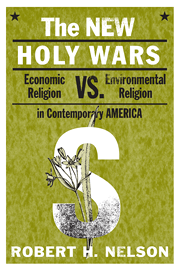Testimony Before the U.S. House Subcommittee on Public Lands and Environmental Regulation
My name is Robert H. Nelson. I am a professor in the School of Public Policy at the University of Maryland and a senior fellow of The Independent Institute. From 1975 to 1993 I worked as a senior economist in the Office of Policy Analysis within the Office of the Secretary of the Department of the Interior. Based on this experience, since the 1980s I have written three books and many scholarly—and also more popular—articles about the system of public land management by the Forest Service and the BLM.
I am pleased to be able to testify today on such an important subject. The public lands are an important part of the history of the United States, and still represent today 28 percent of the land area of the United States, including around 50 percent of all the land in the western states.
I am encouraged by the introduction of H.R. 3294, the “State-Run Federal Lands Act.” There has been a virtual consensus since the 1990s among public land experts that the federal land management system is not working well. The inability to deal effectively with forest health and western wildland fire in recent years is only the most visible symptom of a wider set of public land management dysfunctions.
Major change of some kind is therefore desperately needed. The relationship between the federal government and the western states for the management of the public lands is based on outmoded ideas that are now 100 years old. This relationship needs to be rethought in light of contemporary realities. If we can avoid partisan acrimony, H.R. 3294 can valuably help to open the discussion.
I specifically like the idea of developing a federal-state relationship for significant areas of public lands in which the federal government retains the underlying land ownership and certain broad guidance responsibilities but the main management function is devolved to new administrative units at the state level—and in some cases even lower to the local government level. I would also recommend in other cases making provision for devolving new administrative responsibilities to nongovernmental groups organized at the local level that would have a board of directors. This would build on the widespread development in recent years of self-organized local advisory bodies in the West seeking to work with the Forest Service and BLM. This role might now shift from merely advisory to taking on suitable direct administrative functions.Seeking to respond to increasing evidence of public discontent, the Congress in the 1970s enacted a wave of major public land legislation including the Resources Planning Act of 1974, the National Forest Management Act of 1976 and the Federal Land Policy and Management Act of 1976. The Congress failed, however, to resolve the large tensions between the progressive-era ideal of management by government experts that still retained significant influence and a new post-1960s concern to give non-government organizations and popular democracy a much larger decision role. The mandated federal land use planning soon became bogged down in public controversy and widespread litigation.
As has been the case in many areas of American governance in recent decades, the federal judiciary stepped in to fill the vacuum. This increasing judicial role was a major factor in a radical 1990s shift in the goals of public land management, the move to a new philosophy of ecosystem management focused on environmental goals such as biodiversity, replacing the previous longstanding public land management philosophy of multiple use and sustained yield.
Ecosystem management has been no more successful in providing a clear direction for public land management than the ineffective land use planning spawned by the 1970s legislation. By the 1990s, the 1970s management framework was judged a failure on a bipartisan basis at conferences and other meetings of public land experts to describe the workings of Forest Service and BLM land management. It proved impossible for Congress, however, to address the large management problems on the public lands that were becoming evident by the 1990s. No major public land legislation has passed since the 1970s.
The most important role for the Congress at present is to create a statutory basis for opening up a much wider range of devolved land administration alternatives and to set the terms for review and approval and subsequent oversight of these alternatives as they are put into practice. There should be ample opportunities not only for state governments but also local governments and local citizen groups to propose innovative devolved public land administration arrangements and a process by which these proposals can be fairly and expeditiously reviewed. H.R. 3294 is an important step in that direction.












